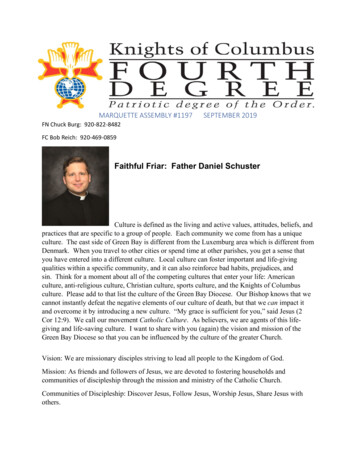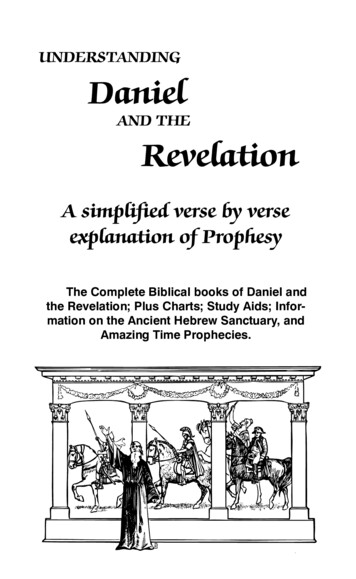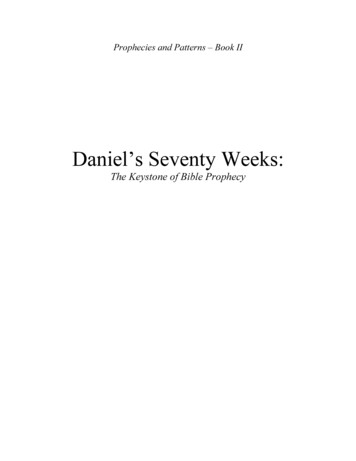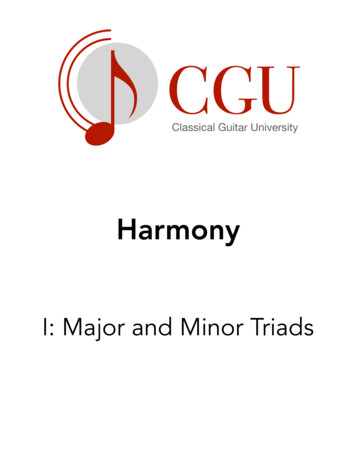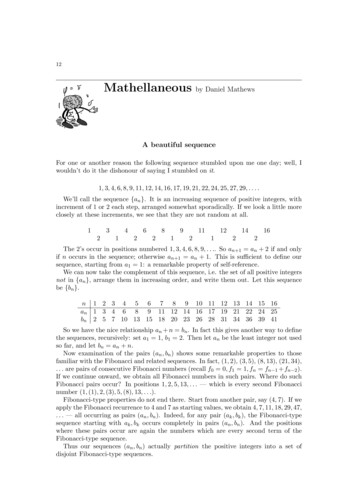
Transcription
12Mathellaneousby Daniel MathewsA beautiful sequenceFor one or another reason the following sequence stumbled upon me one day; well, Iwouldn’t do it the dishonour of saying I stumbled on it.1, 3, 4, 6, 8, 9, 11, 12, 14, 16, 17, 19, 21, 22, 24, 25, 27, 29, . . . .We’ll call the sequence {an }. It is an increasing sequence of positive integers, withincrement of 1 or 2 each step, arranged somewhat sporadically. If we look a little moreclosely at these increments, we see that they are not random at all.13241628291112121142162The 2’s occur in positions numbered 1, 3, 4, 6, 8, 9, . . . So an 1 an 2 if and onlyif n occurs in the sequence; otherwise an 1 an 1. This is sufficient to define oursequence, starting from a1 1: a remarkable property of self-reference.We can now take the complement of this sequence, i.e. the set of all positive integersnot in {an }, arrange them in increasing order, and write them out. Let this sequencebe {bn }.n 1 2 3 4 5 6 7 8 9 10 11 12 13 14 15 16an 1 3 4 6 8 9 11 12 14 16 17 19 21 22 24 25bn 2 5 7 10 13 15 18 20 23 26 28 31 34 36 39 41So we have the nice relationship an n bn . In fact this gives another way to definethe sequences, recursively: set a1 1, b1 2. Then let an be the least integer not usedso far, and let bn an n.Now examination of the pairs (an , bn ) shows some remarkable properties to thosefamiliar with the Fibonacci and related sequences. In fact, (1, 2), (3, 5), (8, 13), (21, 34),. . . are pairs of consecutive Fibonacci numbers (recall f0 0, f1 1, fn fn 1 fn 2 ).If we continue onward, we obtain all Fibonacci numbers in such pairs. Where do suchFibonacci pairs occur? In positions 1, 2, 5, 13, . . . — which is every second Fibonaccinumber (1, (1), 2, (3), 5, (8), 13, . . .).Fibonacci-type properties do not end there. Start from another pair, say (4, 7). If weapply the Fibonacci recurrence to 4 and 7 as starting values, we obtain 4, 7, 11, 18, 29, 47,. . . — all occurring as pairs (an , bn ). Indeed, for any pair (ak , bk ), the Fibonacci-typesequence starting with ak , bk occurs completely in pairs (an , bn ). And the positionswhere these pairs occur are again the numbers which are every second term of theFibonacci-type sequence.Thus our sequences (an , bn ) actually partition the positive integers into a set ofdisjoint Fibonacci-type sequences.
Mathellaneous131, 2, 3, 5, 8, 13, 21, 34, . . .4, 7, 11, 18, 29, 47, 76, 123, . . .6, 10, 16, 26, 42, 68, 110, 178, . . .9, 15, 24, 39, 63, 102, 165, 267, . . .12, 20, 32, 52, . . .It’s not obvious that such a partition exists, at first thought, nor is it easy to constructthese sequences from scratch. (Observe that a greedy algorithm, taking least unusednumbers at each stage, doesn’t work.) Is this the only such partition?Consider, now, where these Fibonacci-type sequences start. We have (a1 , b1 ) (1, 2)starts the first sequence, (a3 , b3 ) (4, 7) starts the second, (a4 , b4 ) starts the third, then(a6 , b6 ), then (a8 , b8 ). In general, (an , bn ) starts one of these Fibonacci-type sequences ifand only if n occurs in our sequence {an }, in another startling display of self-reference.This gives us another construction for an , bn . Start with (a1 , b1 ) (1, 2). We extendthis to a full Fibonacci sequence and place it at terms numbered by every secondFibonacci number, so (a2 , b2 ) (3, 5), (a5 , b5 ) (8, 13), . . . Having done this, we findthe least unnumbered spot and set a3 4, the least positive integer unused so far.Then we set b3 a3 3 7, and proceed to fill in all the terms of this Fibonacci-typesequence by a similar rule. Continue inductively to define an , bn .The considerations above give the equation an bn abn . In fact there are morerelationships of this form ([3], [10], [13], [17]):aan bn 1,abn an bn ,ban an bn 1,bbn an 2bn .Our sequence arises not only from idle numerology, but in various concrete situations. Consider the lattice points in the positive quadrant of the plane, (m, n) Z2 ,m, n 0. I have mathematical lighthouses which shine trifurcated light — upwards,rightwards and diagonally right-up. (i.e. along vectors (1, 0), (0, 1), (1, 1) ). I want tolight up the entire quarter-infinite lattice. (A lighthouse lights its own point, and thelight shines through other lighthouses.) Call a point “dark” or “lit” accordingly.One way to proceed is as follows. Obviously, there must be a lighthouse at (0, 0).This shines on every point (n, 0), (0, n) and (n, n). Then, the two dark points closest to the origin are (1, 2) and (2, 1). Place lighthouses at these points, and continue in this fashion. The next points to receive lighthouses are then (3, 5), (5, 3), then
14Daniel Mathews(4, 7), (7, 4), (6, 10), (10, 6), . . . A little reflection will show that the nth pair of points(xn , yn ), (yn , xn ) satisfy yn xn n, and xn is the least x-coordinate thus far unused.So the points with lighthouses are exactly the points (an , bn ) and (bn , an ).The lighthouses appear to lie along two “lines” enclosing a “cone”. Points inside thecone receive light travelling diagonally from a lighthouse; those outside receive lightfrom just one lighthouse, travelling horizontally or vertically. For this reason we willcall the cone a “light cone”, relativity theory notwithstanding. This is in a sense themost “energy efficient” way to place our lighthouses: it is the only way to light up thequarter-plane such that no two lighthouses lie on the same row, column or diagonal.This situation is the set-up for a simple 2-player game, invented by Rufus P. Isaacs,first described in [2] and named “Corner the Lady” by Martin Gardner [8]. It can beplayed online at [23]. We have a quarter-infinite chessboard, on which is placed onequeen. Two players take it in turns to move the queen. However, unlike a normalqueen, this piece only moves towards the origin (i.e. down, left, or diagonally downleft), any number of squares. Players cannot pass; the player who moves the queen tothe origin wins.It’s not difficult to see that this chessboard game is closely related to a variant ofthe game of Nim, known as Wythoff ’s Nim [20] and played in China as tsianshidsi(“choosing stones”). It can also be played online at [24]. We have two non-negativeintegers, A and B. Two players take it in turns to decrease numbers. On their turn, aplayer may decrease A by any amount provided it remains a non-negative integer. Orthey may decrease B in similar fashion. Or, they may decrease both A and B by thesame amount, again provided A, B remain non-negative integers.Who has a winning strategy? The answer depends on the initial state, i.e. the initialposition of the queen or values of A and B. The game satisfies criteria known to gametheorists showing that the game is completely soluble. It’s quite clear, for a start, thatif you move the queen to the bottom row or leftmost column, you are going to lose— your opponent will move the queen to the origin next turn. Similarly, if you moveonto the main diagonal y x. In fact, you can see that the closest “safe” points tothe origin are (1, 2) and (2, 1). If you move the queen to one of these points, then youropponent must move to (1, 1), (1, 0), (0, 1), (2, 0) or (0, 2). From any of these squaresyou can move to (0, 0) and win the game.Extrapolating and following similar reasoning, one can show that the only way toavoid loss, against a sufficiently intelligent opponent, is to move to a square with alighthouse, i.e. a square of the form (an , bn ) or (bn , an ). From a safe point with alighthouse, you can only move to unsafe points. And from every unsafe point you canreach the shelter of a lighthouse. So if the queen starts on a lighthouse, player 2 has awinning strategy. Otherwise player 1 has a winning strategy.In fact this diagram has great relevance to another game, this time more purelynumber-theoretic. The Game of Euclid ([4], [7]) is a game for two players, and westart with two positive integers. On their turn, a player may subtract any (positive)multiple of the smaller number from the larger, provided that both numbers remainnon-negative. So, if the game starts with (12, 5), then the first player could move to(7, 5) or (2, 5). The player who reduces one of the numbers to zero wins. The objectof the game, then, is to perform a complete Euclidean algorithm on the two initialnumbers (hence the name!).We can analyse the game on our lighthouse chessboard again. Moving to (n, 1) or(1, n) is a bad idea, as your opponent will win on the next move. The closest “safe”
Mathellaneous15points to the origin are (2, 3) and (3, 2), from which your opponent must move to (2, 1)or (1, 2), from which you have an assured victory.Indeed, one can prove that the light cone, minus the main diagonal, is precisely the“safe” region for this game: to win against a sufficiently intelligent opponent, you mustalways move to this region. From outside the light cone at a point say (x, y) withx y, you can always move into the light cone minus diagonal (if x is not a factor ofy), or to (x, 0) (otherwise) and win. This follows from the fact that the height of thelight cone in column x is precisely x squares. (Count points with lighthouses as outsidethe light cone.) And from the safe region, you can only move into unsafe lands. Thisgives a geometric interpretation which seems more intuitive than the purely algebraicapproach of [4].We now turn to consider the two “lines” of lighthouses bounding the light cone.They do indeed lie on a “rounded-down” line.Recall that the Fibonacci numbers satisfy fn 11 5lim φ 1.618033988749894848204586834365 · · · ,n fn2the golden ratio. In fact every Fibonacci-type sequence of positive integers has thisproperty: this follows from the fact that they obey the same recurrence, and that thetwo roots of the characteristic equation are φ and 1 φ (which is negative). Thereforelimn bn φ,anand we expect the lighthouses to lie asymptotically on the lines y φx, y x/φ.We can do even better than this. If bxc denotes the integer part function, it isactually true that an bnφc and bn bnφ2 c. So the lighthouses lie on the linesy φx, y x/φ to the nearest integer.The sequences an , bn give an example of Beatty sequences, so-named after Beatty’sbeautiful theorem, first proposed as a problem in the American Mathematical Monthlyin 1926 [1]: if α, β are two positive irrational numbers satisfying α1 β1 1, then thetwo sequencesbαc, b2αc, b3αc, b4αc, . . .andbβc, b2βc, b3βc, b4βc, . . .partition the integers. That is, they are disjoint but include every positive integer.The proof of Beatty’s theorem is truly elegant, considering perhaps the unexpectedness of the result. This proof is originally due to Ostrowski and Hyslop and can befound in [6], [12], [16]. There is also a more direct proof by contradiction, in [7].Consider how many members there are of each sequence less than some positiveinteger N . Clearly there are bN/αc in the first sequence, and bN/βc in the second. Soin total there are NN (1)αβNnumbers in the two sequences less than N . Now we know Nα β N , but roundingdown takes off more than 0 (since α, β are irrational) and less than 2 (since we rounddown twice). Thus the sum (1) is N 1, and there are N 1 numbers in the twosequences less than N .Thus there is 1 number present less than 2; it must be 1. Then there are 2 numberspresent less than 3; so they must be 1 and 2. Proceeding in this fashion, it follows thatevery positive integer occurs exactly once in our two sequences.
16Daniel MathewsBeing so surprising and elementary, many mathematicians have attempted generalisations of Beatty’s theorem. Uspensky [19] proved that you cannot have three numbersα, β, γ such that the sequences bnαc, bnβc, bnγc together contain each integer exactlyonce, under any conditions. Nor can you have 4 or more such numbers. R.L. Grahamgives a simple proof in [9].While on this theme, consider the sequences fn an n and gn bn n. (Actuallygn and an are the same.)1 2 3 4 5 6 7 8 9 10 11 12 13 14 15 16nfn an n 0 1 1 2 3 3 4 4 5 6 6 7 8 8 9 9gn bn n 1 3 4 6 8 9 11 12 14 16 17 19 21 22 23 25We see that fn is equal to the number of terms of the sequence {gk } such that gk n.And reciprocally, gn is equal to the number of terms of the sequence {fk } such thatfk n.In fact the same applies, starting not just with an , bn , but starting with any twoincreasing sequences partitioning the positive integers. The reader is encouraged totake any two such sequences {pn }, {qn }, form the sequences {pn n}, {qn n}, and seewhat happens! This much, and more, is a remarkable theorem of Lambek and Moser[15], treated also in [12].Finally, consider the Fibonacci base number system, also known as Zeckendorf arithmetic ([18], [22]). This is like other number bases, with digits 0 and 1, except thatthe place values are 1, 2, 3, 5, 8, 13, . . . and we add the restriction that no two 1s maybe adjacent. We can denote the Fibonacci base by a subscript φ; indeed it functionssimilarly to a “base-φ” system. The first few numbers written in Fibonacci base are0101102103104105106107108109101010 0φ 1φ 10φ 100φ 101φ 1000φ 1001φ 1010φ 10000φ 10001φ 10010φThe numbers ending in 0 in the Fibonacci base are 0, 2, 3, 5, 7, 8, 10, . . . These numbers are precisely an 1. It is an interesting exercise to devise a strategy for winningWythoff’s Nim purely in terms of these Fibonacci representations ([8], [17]). Investigations of the Fibonacci base and this game have run quite deep (e.g. [3]).We conclude our tour of some of the properties of this remarkable sequence at thispoint. The diligent reader should be able to prove all the assertions made here. Surelythere is much more of interest to reward the keen investigator.This sequence {an }, its complementary sequence {bn }, and associated mathematicalobjects cannot help but remind us of James Jeans’ famous assertion that God is amathematician. The appearance of such elementary objects in so many different realms,with such unexpected and elegant results, conjures up the sense of awe and curiositythat is at the heart of mathematical inquiry.
Mathellaneous17I will leave the reader with a problem I met through mathematical olympiad encounters. It is from the Iranian olympiad training programme of 2000; thanks to Angelo DiPasquale for locating the source. The answer will come as no surprise.Problem. Suppose f : N N is a function such that f (1) 1 and f (n) 2 if n f (f (n) n 1)f (n 1) f (n) 1 otherwiseProve that f (f (n) n 1) {n, n 1} and find the function f .References[1] S. Beatty, Problem 3173, Amer. Math. Monthly 33 (1926), 159.[2] C. Berge, The theory of graphs and its applications, (Wiley 1961), chapter 6.[3] M. Bicknell-Johnson, Generalized Wythoff numbers from simultaneous Fibonacci representations,Fibonacci Quart. 23 (1985), 308–318.[4] A.J. Cole and A.J.T. Davie, A game based on the Euclidean algorithm and a winning strategy forit, Math. Gaz. 53 (1969), 354–7.[5] I.G. Connnell, A generalization of Wythoff ’s game, Canad. Math. Bull. 2 (1959), 181–190.[6] H.S.M. Coxeter, The golden section, phyllotaxis, and Wythoff ’s game, Scripta Math. 19 (1953),135–143.[7] A. Engel, Problem-Solving Strategies, (Springer New York 1998), chapters 6 & 13.[8] M. Gardner, Wythoff ’s nim in Penrose tiles to trapdoor ciphers, (Freeman New York 1989), chapter8.[9] R.L. Graham, On a theorem of Uspensky, Amer. Math. Monthly 70 (1963), 407–409.[10] V.E. Hoggatt Jr, M. Bicknell-Johnson and R. Sarsfield, A generalization of Wythoff ’s game, Fibonacci Quart. 17 (1979), 198–211.[11] J.C. Holladay, Some generalizations of Wythoff ’s game and other related games, Math. Mag. 41(1968), 7–13.[12] R. Honsberger, Ingenuity in Mathematics, (Random House/Singer School Division 1970; MAA1998), essay 12.[13] A.F. Horadam, Wythoff pairs, Fibonacci Quart. 16 (1978), 147–151.[14] H.E. Huntley, The divine proportion, (Dover 1970).[15] J. Lambek and L. Moser, Inverse and complementary sequences of natural numbers, Amer. Math.Monthly 61 (1954), 454–458.[16] A. Ostrowski and J. Hyslop, Solution to Problem 3177, Amer. Math. Monthly 34 (1927), 159.[17] R. Silber, A Fibonacci property of Wythoff pairs, Fibonacci Quart. 15 (1977), 85–88.[18] G.J. Tee, Russian peasant multiplication and Egyptian division in Zeckendorf arithmetic, Aust.Math. Soc. Gaz. 30 (2003), 267–276.[19] J.V. Uspensky, On a problem arising out of the theory of a certain game, Amer. Math. Monthly34 (1927), 516–521.[20] I.I. Wythoff, Nieuw Arch. v. Wisk. 7 (1907) 199.[21] A.M. Yaglom and I.M. Yaglom, Challenging mathematical problems with elementary solutions, Vol.2 (1967), 20, 105.[22] E. Zeckendorf, Represéntation des nombres naturels par une somme de nombres de Fibonacci oules nombres de Lucas, Bull. Soc. Roy. Sci. Liège 41 (1972), 179–82.[23] ml [sic][24] http://sciris.shu.edu/ borowski/WythoffDepartment of Mathematics and Statistics, The University of Melbourne, VIC 3010E-mail : D.Mathews@ms.unimelb.edu.au
n) starts one of these Fibonacci-type sequences if and only if n occurs in our sequence {a n}, in another startling display of self-reference. This gives us another construction for a n,b n. Start with (a 1,b 1) (1,2). We extend this to a full Fibonacci sequence and place it at terms numbered by every


